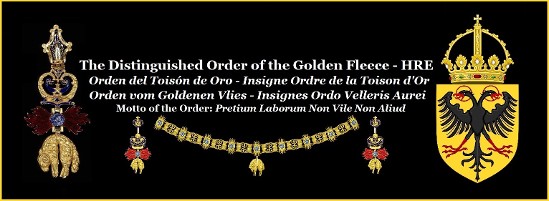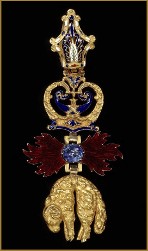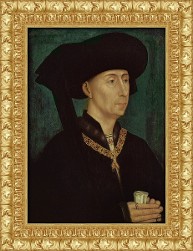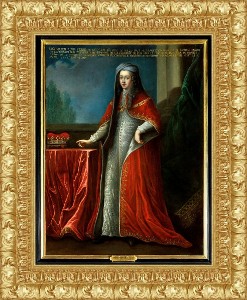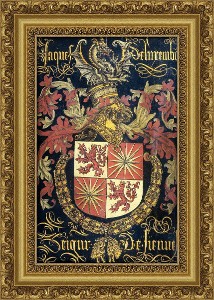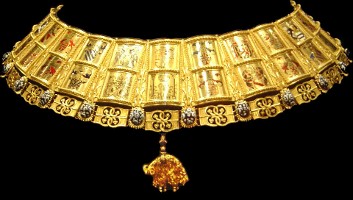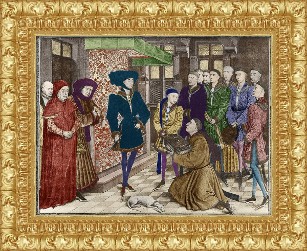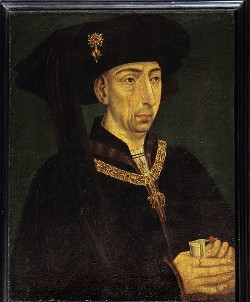
|
Distinguished Order of the Golden Fleece - HRE The Distinguished Order of the Golden Fleece (Spanish: Insigne Orden del Toisón de Oro, German: Orden vom Goldenen Vlies) is a Catholic order of chivalry founded in Bruges by Philip the Good, Duke of Burgundy, in 1430, to celebrate his marriage to Isabella of Portugal. The Order of the Golden Fleece has been associated with the Holy Roman Empire through out its history.
Historical background of the Order The Order of the Golden Fleece was established on 10 January 1430, by Philip the Good, Duke of Burgundy (on the occasion of his wedding to Isabella of Portugal), in celebration of the prosperous and wealthy domains united in his person that ran from Flanders to Switzerland. The jester and dwarf Madame d'Or performed at the creation of the order of the Golden Fleece in Bruges. It is restricted to a limited number of knights, initially 24 but increased to 30 in 1433, and 50 in 1516, plus the sovereign. The order's first king of arms was Jean Le Fèvre de Saint-Remy. It received further privileges unusual to any order of knighthood: the sovereign undertook to consult the order before going to war; all disputes between the knights were to be settled by the order; at each chapter the deeds of each knight were held in review, and punishments and admonitions were dealt out to offenders, and to this the sovereign was expressly subject; the knights could claim as of right to be tried by their fellows on charges of rebellion, heresy and treason, and Charles V conferred on the order exclusive jurisdiction over all crimes committed by the knights; the arrest of the offender had to be by warrant signed by at least six knights, and during the process of charge and trial he remained not in prison but in the gentle custody of his fellow knights. The order, conceived in an ecclesiastical spirit in which mass and obsequies were prominent and the knights were seated in choirstalls like canons, was explicitly denied to heretics, and so became an exclusively Catholic honour during the Reformation. The officers of the order were the chancellor, the treasurer, the registrar, and the king of arms (herald, toison d'or).
The Duke's stated reason for founding this institution had been given in a proclamation issued following his marriage, in which he wrote that he had done so "for the reverence of God and the maintenance of our Christian Faith, and to honor and exalt the noble order of knighthood, and also ... to do honor to old knights; ... so that those who are at present still capable and strong of body and do each day the deeds pertaining to chivalry shall have cause to continue from good to better; and ... so that those knights and gentlemen who shall see worn the order ... should honor those who wear it, and be encouraged to employ themselves in noble deeds ..."
The choice of the Golden Fleece of Colchis as the symbol of a Christian order caused some controversy, not so much because of its pagan context, which could be incorporated in chivalric ideals, as in the Nine Worthies, but because the feats of Jason, familiar to all, were not without causes of reproach, expressed in anti-Burgundian terms by Alain Chartier in his Ballade de Fougères referring to Jason as "Who, to carry off the fleece of Colchis, was willing to commit perjury." The bishop of Châlons, chancellor of the order, identified it instead with the fleece of Gideon that received the dew of Heaven (Judges 6:37).
The badge of the order, in the form of a sheepskin, was suspended from a jewelled collar of firesteels in the shape of the letter B, for Burgundy, linked by flints; with the motto Pretium Laborum Non Vile ('No Mean Reward for Labours') engraved on the front of the central link, and Philip's motto Non Aliud ('I will have no other') on the back (non-royal knights of the Golden Fleece were forbidden to belong to any other order of knighthood).
During this time, the Burgundian court was culturally leading in Europe and so the new order, with its festivals, ceremonies, rituals and constitution, was seen by many as a role model in the sense of a princely order based on the ideals of Christian chivalry. Aid to the Byzantine Empire or the pushing back of the Ottomans was repeatedly promoted by the Burgundian dukes in connection with their order. The Burgundian fleet actually crossed Rhodes and the Black Sea, but all of the ideas came from an extended planning phase that was not yet complete. After the death of Charles the Bold in an attempt to conquer the Duchy of Lorraine caused the extinction of the House of Burgundy in 1477, the order passed to the House of Habsburg. A few months after his marriage to the heiress Mary of Burgundy, Emperor Maximilian of Habsburg was knighted in Bruges on April 30, 1478, and then appointed sovereign (grand master) of the order. All renegade or disloyal knights of the order in the course of the subsequent War of the Burgundian Succession were expelled from the order by Maximilian. The memory of the dead was erased and their coats of arms were broken
From Emperor Charles V or King Philip II of Spain, the sovereign was on the one hand the head of the Spanish line of the Habsburgs and on the other hand also king of Spain. Charles V was appointed head of the order at the age of 9 and identified himself strongly with this community throughout his life. The ideal of chivalrous and brave living was brought to him by William de Croÿ. When in 1700 Charles II of Spain died childless, both the Habsburgs from the Habsburg lands and the Bourbons, as the new kings of Spain, claimed sovereignty of the order. Both noble houses basically invoked their claims regarding the Spanish crown. The House of Habsburg's claim relied on Article 65 of the Statutes. Holy Roman Emperor Charles VI was able to claim sovereignty of the Netherlands, the Burgundian heartland, during the War of the Spanish Succession and thus he could celebrate the order's festival in Vienna in 1713. As with Maximilian I or Charles V, the order was again closely associated with the Holy Roman Empire. Regardless of this, the order was divided into two lines. The Habsburg order owns the archive and the old insignia and adheres more to the original statutes. Thus there is today the Spainish Order and the Austrian (Habsburg) Order.
On Christmas Day, In the year of Our Lord 2022 the Chancellor of the Holy Roman Empire Association decreed that the status of the Order of the Golden Fleece is that of a Holy Chivalric Order of the Holy Roman Empire, the Chancellor of the HREA assumed the Title and Rank of Nominal Sovereign Prince Grand Master of the Order of Golden Fleece of the Holy Roman Empire with all rights and patrimony of the said Holy Chivalric Order of the Holy Roman Empire.
Rank and Membership of the Order Membership of the Order of Golden Fleece of the Holy Roman Empire has one category only and is limited to 50 Knights as set by the decree of 1516. Knights of the Order are entitled to be addressed with the style His / Her Excellency in front of their name.
Motto of the Order Pretium Laborum Non Vile Non Aliud - I will have no other November 30 (feast day of St. Andrew the Apostle, patron saint of Burgundy) is the day of the order, when new members are accepted into the order.
 Present day status of the Order The present status of the Order of the Golden Fleece of the Holy Roman Empire, is that of a Holy Chivalric Order of the Holy Roman Empire, as such all Rights, Patrimony and Property (including the usage of all Armorial Bearings, Signs and Symbols), of the Order of Golden Fleece of the Holy Roman Empire, come under the exclusive ownership and protection of the Holy Roman Empire Association - ASSOCIAZIONI dei NOBILI del SACRO ROMANO IMPERO. The Present Nominal Sovereign Prince Grand Master of the Order of Golden Fleece of the Holy Roman Empire is the Chancellor of the Holy Roman Empire Association. Copyright (C) 1430-2023 - The Holy Roman Empire Association, hold full International Copyright to the Order of the Golden Fleece of the Holy Roman Empire
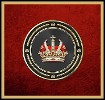     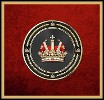
|


